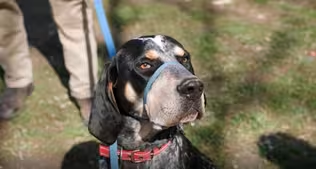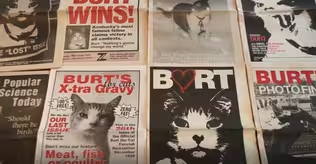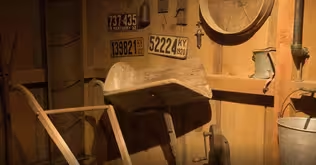
Lost River Cave
Clip: Season 31 Episode 2 | 6m 9sVideo has Closed Captions
Explore Lost River Cave and discover the inspiring conservation efforts that protect it.
Lost River Cave boasts a rich and varied history, having served as a shelter for Paleo-Indian groups, a grist mill, a Civil War encampment, a lively nightclub, and even a dumping ground. In 1990, the non-profit organization The Friends of Lost River was formed with a mission to restore and preserve this remarkable site for future generations.
Problems playing video? | Closed Captioning Feedback
Problems playing video? | Closed Captioning Feedback
Kentucky Life is a local public television program presented by KET
You give every Kentuckian the opportunity to explore new ideas and new worlds through KET. Visit the Kentucky Life website.

Lost River Cave
Clip: Season 31 Episode 2 | 6m 9sVideo has Closed Captions
Lost River Cave boasts a rich and varied history, having served as a shelter for Paleo-Indian groups, a grist mill, a Civil War encampment, a lively nightclub, and even a dumping ground. In 1990, the non-profit organization The Friends of Lost River was formed with a mission to restore and preserve this remarkable site for future generations.
Problems playing video? | Closed Captioning Feedback
How to Watch Kentucky Life
Kentucky Life is available to stream on pbs.org and the free PBS App, available on iPhone, Apple TV, Android TV, Android smartphones, Amazon Fire TV, Amazon Fire Tablet, Roku, Samsung Smart TV, and Vizio.
Providing Support for PBS.org
Learn Moreabout PBS online sponsorshipLost River Cave boasts a rich and varied history, having served as shelter for Paleo-Indian groups, a gristmill, a Civil War encampment, a lively nightclub, and even a dumping ground.
Back in 1990, the nonprofit organization the Friends of Lost River was formed with the mission to restore and preserve this remarkable site for future generations.
Thanks to their efforts, the cave reopened to the public in 1997.
Come along as we explore Lost River Cave and discover the inspiring conservation efforts that continue to protect this unique landmark.
[music playing] Lost River Cave is a 72-acre park in the heart of Bowling Green.
It's literally right in the middle of the city.
What you'll find is two miles of trails through our closed karst valley.
It's one of the largest karst valleys in the world, and it's home to several different ecosystems.
We have vernal pools, we have mesic meadows, we have blue holes, caves, and, you know, our barrens prairie, as well as a wetland.
So, there's a lot of different fragile ecosystems on our park.
The cave is still fairly young.
It is still forming.
We still have, of course, the river flowing through.
So, during high water events, the water can rise as high as the ceiling, which can knock off some of the stalactite formations that are in there.
So, you don't see a ton of formations, but we do have some beautiful flowstone.
We also have drapery in those types of formations in the cave.
[music playing] Now, we don't want anybody to get so excited that they fall out of the boat, but what you're about to see is the largest stalactite on our tour.
This is known as the praying hands.
It looks like upside-down praying hands.
You go into the cave and you immediately hear the rushing of the water.
The sense of awe just kind of comes over you as you really embrace the history that you're immersed in.
[music playing] A lot of the history here at Lost River Cave, of course, began with those Paleo Native Americans back 9,000 to 10,000 years ago.
So, Paleo Native Americans would have been traveling through the area and this would have been more of a stop for them, an area where they could probably do some bartering and trading, and they would also do a lot of hunting.
Throughout the cliff rock, we've actually found piles of arrowheads and shards of arrowheads where they would continuously go back to these same points to hunt over and over again.
So, it was a great spot as they're traveling to refresh on their water, their food source.
Of course, the shelter in the cave kept them warm or cool, depending on what time of year they were here in the area.
It was also used during the Civil War.
Civil War soldiers in the cave were actually using their candles to leave behind their signatures.
We have names and dates and companies that they were with.
We've been able to actually go back and find military records and pension records that match up with the names that we have in our cave.
[music playing] Early settlers using the cave used it as a milling operation.
There were different types of mills.
One of the original mills was located on the inside of the cave, and of course, the farmers would pull across the top, hoist down their product.
They would send it in for the milling process.
It was brought back out, sent back up to the farmers.
Over time with the water, being that we are that drainage basin, the mill would actually flood, so they would constantly be rebuilding the mill.
They eventually built one on top, drilling through around 50 feet of bedrock to run their shaft and their undershot waterwheel, and that waterwheel would power the mill up on top.
There's a lot of history about it being used for some of the Prohibition era, where there was a little bit of that alcohol smuggling going on in and out of the cave.
At one point, one of the mills here was actually a peach and brandy wine distillery.
They already probably had this set up here for them to do that.
Then, of course, you move into the 1930s, and that is when Prohibition ended and that's when the nightclub opened up.
[music playing] It was a happening spot.
It was featured in Billboard magazine.
It was considered to be one of the only air-conditioned nightclubs in the country because, of course, the cave stays 57 degrees.
It blew out cool gusts of air that would cool off the patrons.
They would trek down around 200 stairs down to the mouth of the cave, where they would enjoy the music.
There were famous bands, Dinah Shore, NBC Orchestra, Francis Craig.
They raced across the country once we were featured in that Billboard, which kind of put us on the map.
[music playing] After our nightclub closed down, the city of Bowling Green, they just kind of started throwing all their trash down here.
It was not a landfill.
It was an illegal dump site.
People would back up to the edge of the mouth of the cave behind me and toss whatever they didn't need over the edge, you know, out of sight, out of mind.
It was a very dark time for Lost River Cave.
As a kid coming down when it was closed, it was kind of disheartening.
You would see all of the trash, and it's just a beautiful cave, and you wonder why your community had forgotten that you had such a wonder in your own backyard.
A lot of the concrete had fallen in.
The walls along, you know, the valley walk here had gone, you know, unrepaired, and so it was kind of dismal at that point.
And so, once the Friends of Lost River came into play, and the university donated it, and this whole program coming about, Lost River Cave has really grown and become such a beautiful place that it should have never been neglected as it was.
[music playing] So, the Friends of Lost River is our non-profit 501(c)(3) organization, and it is just members of Bowling Green that wanna see this place flourish, be protected, and conserved over the years.
So, the future of Lost River Cave is bright.
Of course, we're gonna always make sure that we're maintaining and protecting this property.
But we work very hard to restore all the ecosystems and nurture them, and just make sure that Bowling Green always has this property as a source of reconnection with nature.
[music playing]
Video has Closed Captions
Clip: S31 Ep2 | 8m 39s | The Kentucky town whose mayor is a... dog? (8m 39s)
The Official Burt the Cat Fanclub Newsletter, the Story
Video has Closed Captions
Clip: S31 Ep2 | 5m 57s | The Official Burt the Cat Fanclub Newsletter was a newspaper that ran in Louisville starting in 1996 (5m 57s)
Preserving the History of the Commonwealth
Video has Closed Captions
Clip: S31 Ep2 | 3m 8s | Chip visits the Thomas D. Clark Center for Kentucky History in Frankfort. (3m 8s)
Providing Support for PBS.org
Learn Moreabout PBS online sponsorshipSupport for PBS provided by:
Kentucky Life is a local public television program presented by KET
You give every Kentuckian the opportunity to explore new ideas and new worlds through KET. Visit the Kentucky Life website.
















